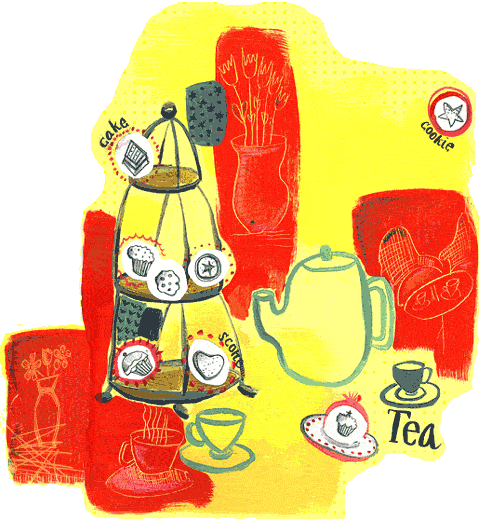This is a wonderful meal that we made when we did a feast for the kids after studying a month-long unit on Kings and Queens. I hope you'll enjoy these recipes as much as we did. The only recipe that is lacking from this list is a 5$ rotisserie chicken from your local grocery store! Everyone loved the food at our feast, and it was fun to eat flowers! We sometimes make these just for fun, because they all were so tasty.
"A Salat" (Salad)
Serves 6
Salads, made mainly of herbs, were popular throughout the Middle Ages, often served at the start of a meal, rather than after the main course. The make up of the salad would change according to the season and what grew in the cook's herb garden, so feel free to adapt this basic recipes desired. Do NOT make it with dried herbs!
- 2 bunches of watercress
- 2 cartons of mustard and cress
- 1 medium leek, very finely sliced
- 6 spring onions or scallions, chopped small
- 1 bulb of fennel, slicked in thin match-sticks
- 1 large handful of fresh parsley, pull off into small sprigs
- the leaves from 1 young sprig of fresh rosemary
- the leaves from 4-6 prigs of fresh mint, slightly chopped
- 6 fresh sage leaves, slightly copped
- the leaves from 2 small branches of thyme
- a few leaves from any other herb you have (take care not to use too much of any very strong flavored ones)
- sea salt and freshly ground black pepper
- 2-3 tablespoons wine vinegar
- 4-5 tablespoons olive oil
- edible flowers (optional)
Wash the cresses, herbs and fennel and dry all thoroughly. Mix them,with the leek and spring onions, in a large bowl, sprinkle with salt and pepper, and mix again. Mix the oil with the vinegar and pour over the salad just before serving.
*******
*******
"Savoury Tosted or Melted Cheese"
(Brie Cream Sauce)
Makes 1 cup -- approximately 8 servings
Makes 1 cup -- approximately 8 servings
- 1/4 cup butter
- 1/4 cup cream cheese
- 1/4 lb Brie or other strongly flavored cheese (farmers will work, but Brie is wonderful)
- 2 Tbsp whole milk (though not in the original recipe, I find that a bit of milk helps gives this a better consistency, and helps the whole thing hang together better)
- 1/4 t white pepper
Melt butter. Melt cream cheese in butter. Add milk. Cut up the farmer's cheese and stir it into the mixture over low heat. You may want to use a whisk to blend the two together, though a spoon will do. It does not to separate. When you have a uniform, creamy sauce you are done.
Serve over toast, put on toast and broil for 30 seconds-1 minute, mix in (or serve over) things like asparagus, bacon, sautéed onions, etc.
*******
*******
Baked Pears
Serves 6-8
- pears, cored
- cinnamon & sugar to taste (optional)
- cloves (optional)
Place whole, cored fruit in a baking dish or pan and bake at 400° F until the fruit has completely turned a deep brown, about 1/2 hour to 45 minutes. Sprinkle with cinnamon & sugar and serve.
This recipe is much less elaborate than it appears in the original, and is simply pears baked in an oven, very much like our contemporary baked apple but without the addition of sugar & spices.
This recipe is much less elaborate than it appears in the original, and is simply pears baked in an oven, very much like our contemporary baked apple but without the addition of sugar & spices.
Baked pears were thought to have medicinal properties and were one of the foods considered appropriate for the ill, hence the instruction to give them to the sick person. Feasts often ended with baked apples & pears, served with the other spices & confections of the dessert course. Keeping that in mind, the modern recipe has been sweetened with a little cinnamon & sugar.
You may also slice them in halves, poke a few cloves in them, sprinkle them with a little brown sugar and a pinch of cinnamon and bake them that way - the sugar will turn to a nice golden syrup. Asian pears taste the best - we have tried three or four different varieties, and this was the one that won the day!
*******
*******
Chyches (baked Chick-Peas)
Serves 6-8
- 3 cups chickpeas, dried or canned
- the cloves of 2 whole garlic bulbs, peeled but left whole
- olive oil
- 1/2 tsp. each pepper & cloves (or season to taste)
- pinch saffron
- dash salt
If using canned peas, rinse well and drain; place chickpeas in a single layer on a baking sheet and roast in a 400° F oven for approx. 45 minutes, turning the peas midway through roasting to evenly cook. (Less time may be required when using dried.) Be sure that they are completely cooked through - the texture and aroma will be that of roasted nuts. Remove from oven; place chickpeas in a pot with the garlic cloves; add enough water to come to about 1/4 to 1/2 inch from the top of the peas. Top off with olive oil, adding enough to just cover the peas. Add spices, and bring to a boil; reduce to a simmer, and continue cooking until garlic softens, about 10-15 minutes. Drain well or serve in the broth; serve hot. Serves 6-8.
*******
*******
Perry of Pesoun (Peas and Onion)
Serves 6-8
- 2 lbs. frozen or fresh shelled peas
- 2-3 small onions, minced
- 3 tbs. olive oil
- salt & sugar to taste
- pinch saffron
Bring to a boil the onions & peas; add the remaining ingredients and return to boil. Reduce heat slightly and cook until the vegetables are tender. Drain & serve. Dress with a little extra olive oil if desired.
The kind of peas available in the Middle Ages would have required additional cooking, hence the instructions in the original recipe to cook the peas until they burst, cool them, then cook again with the other ingredients. Saffron too expensive? Use a drop or two of yellow food coloring instead. Even a hint of turmeric does nicely.
*******
*******
"Makerouns "
(Medieval Macaroni & Cheese - delicious!)
Serves 6-8
Serves 6-8
- 3-4 lb. freshly home-made, un-dried noodles OR 1 lb. dried egg noodles*
- 1 tbs. oil
- large pinch salt
- 2 cups grated cheese (see: How to Cook Medieval - Cheese)
- 1 stick butter
Boil noodles with oil & salt until al dente (tender-crisp). Drain well. In a serving bowl or platter place some melted butter and cheese. Lay noodles on top and add more butter and cheese. Serve as is or continue adding layers of butter, cheese, and noodles. Use extra cheese as necessary. Serve immediately, or place in a hot oven for several minutes and then serve.
Makerouns appears to be the ancestor of macaroni, and this dish may best be described as "medieval mac-n-cheese." The period receipt advises to prepare it like "losyns" (lasagna), with layers of noodles, butter, and cheese. I find Cheddar cheese the tastiest, but feel free to try other varieties. The dish is wonderful when prepared with un-dried freshly made noodles, but works with a dried purchased variety as well.
*The original recipe noodles are essentially boiled pastry dough; if you have a pasta maker, feel free to use it in making your makerouns, boiling them while still fresh and un-dried. Egg noodles are probably the best to use when purchasing a commercial brand. Keep in mind the difference in weight between dried and un-dried noodles.
Recipes taken from the internet a few years ago (not sure who to give credit for as they might all be from different sites!)




















5 comments:
Thank you for the medieval recipes! A friend and I are making several of these for our medieval feast -- a celebration of the 3-month study of the Middle Ages our families have just completed. I checked out some books, but your recipes seem more doable.
Thanks again!
Thanks 4 the Medeval recipes this will help with my project my crazy teacher gave me.
Thanks Again!!!!!!!!!!
Looks like the majority of these recipes came from here:http://www.godecookery.com/goderec/goderec.htm#top
This way others can find this resource as well!
Has anyone tried the Macaroni if so will it feed 10 people and is it good?
⁉潬敶栠睯琠敨敳爠捥灩獥戠楲杮栠獩潴祲愠楬敶琠牨畯桧映潯
Post a Comment